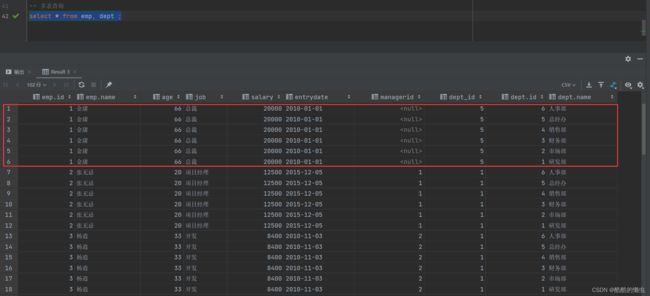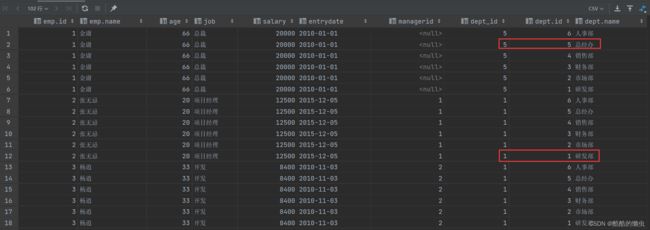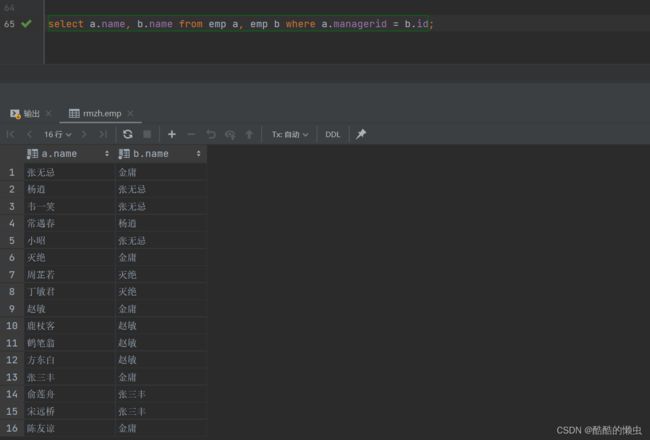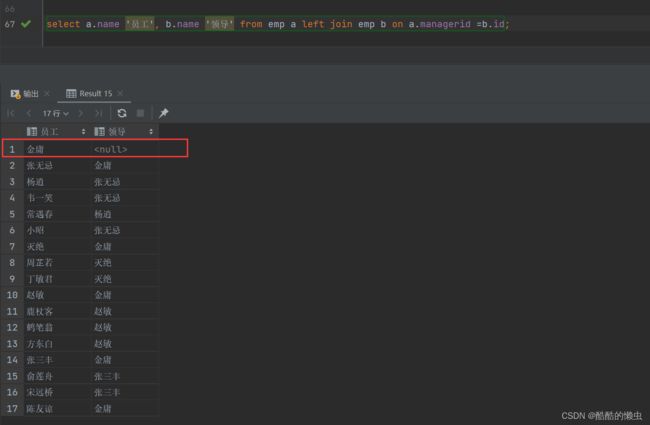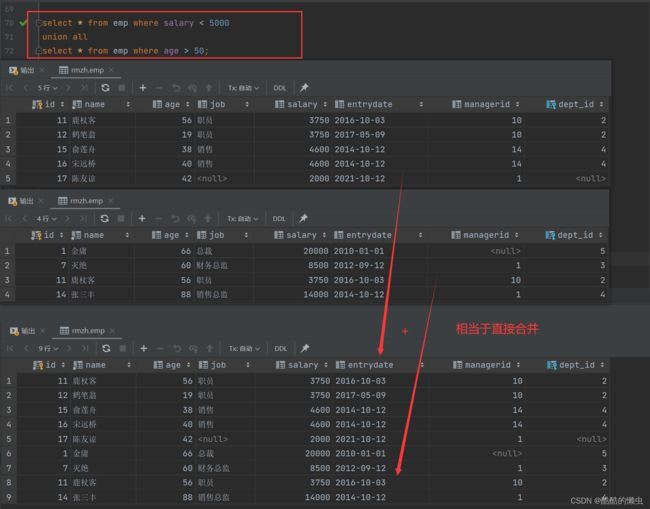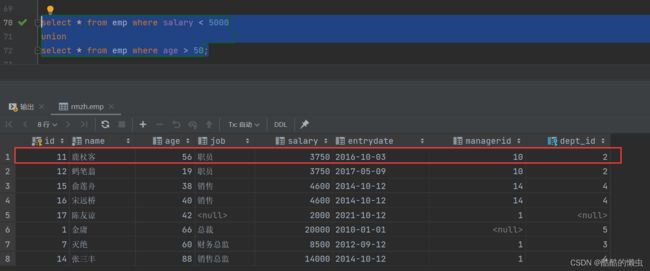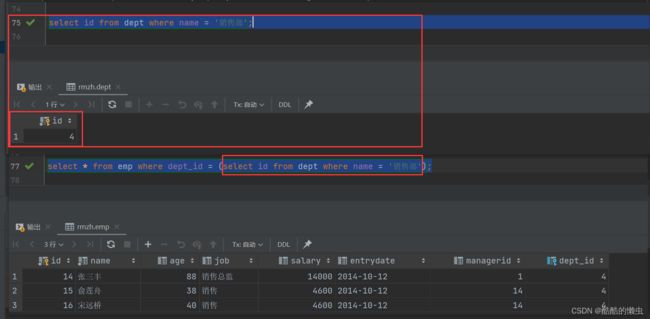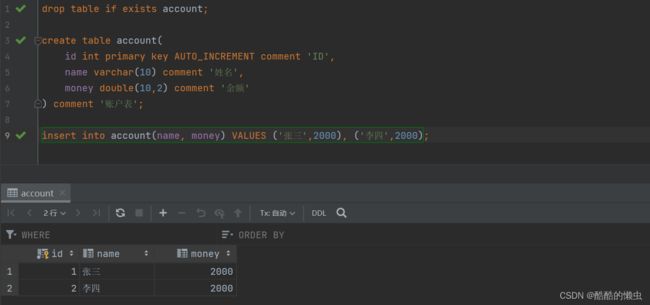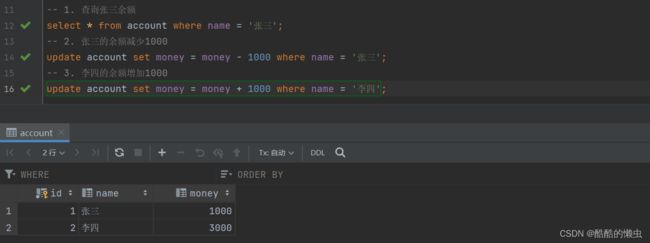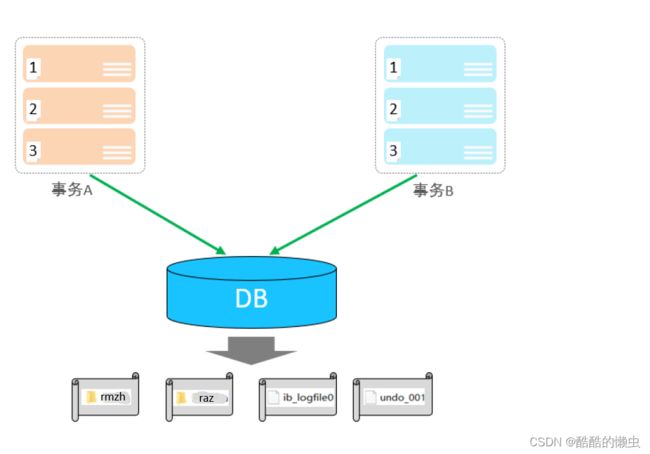MySQL— 基础语法大全及操作演示!!!(下)
MySQL—— 基础语法大全及操作演示(下)
-
- 五、多表查询
-
- 5.1 多表关系
-
-
- 5.1.1 一对多
- 5.1.2 多对多
- 5.1.3 一对一
-
- 5.2 多表查询概述
-
-
- 5.2.1 数据准备
- 5.2.2 概述
- 5.2.3 分类
-
- 5.3 内连接
- 5.4 外连接
- 5.5 自连接
-
-
- 5.5.1 自连接查询
- 5.5.2 联合查询
-
- 5.6 子查询
-
-
- 5.6.1 概述
- 5.6.2 标量子查询
- 5.6.3 列子查询
- 5.6.4 行子查询
- 5.6.5 表子查询
-
- 六、事务
-
- 6.1 事务简介
- 6.2 事务操作
-
-
- 6.2.1 未控制事务
- 6.2.2 控制事务一
- 6.2.3 控制事务二
-
- 6.3 事务四大特性
- 6.4 并发事务问题
- 6.5 事务隔离级别
MySQL— 基础语法大全及操作演示!!!(上)https://blog.csdn.net/weixin_43412762/article/details/132051493
MySQL— 基础语法大全及操作演示!!!(中)https://blog.csdn.net/weixin_43412762/article/details/132261256
MySQL— 基础语法大全及操作演示!!!(下)https://blog.csdn.net/weixin_43412762/article/details/132548235
五、多表查询
在讲解 SQL语句 的时候,讲解了DQL语句,也就是数据查询语句,但是之前讲解的查询都是单表查询,而本章节我们要学习的则是多表查询操作,主要从以下几个方面进行讲解。
5.1 多表关系
项目开发中,在进行数据库表结构设计时,会根据业务需求及业务模块之间的关系,分析并设计表结
构,由于业务之间相互关联,所以各个表结构之间也存在着各种联系,基本上分为三种:
- 一对多(多对一)
- 多对多
- 一对一
5.1.1 一对多
- 案例: 部门 与 员工的关系
- 关系: 一个部门对应多个员工,一个员工对应一个部门
- 实现: 在多的一方建立外键,指向一的一方的主键
5.1.2 多对多
- 案例: 学生 与 课程的关系
- 关系: 一个学生可以选修多门课程,一门课程也可以供多个学生选择
- 实现: 建立第三张中间表,中间表至少包含两个外键,分别关联两方主键
create table student(
id int auto_increment primary key comment '主键ID',
name varchar(10) comment '姓名',
no varchar(10) comment '学号'
) comment '学生表';
insert into student values (null, '黛绮丝', '2000100101'), (null, '谢逊', '2000100102'), (null, '殷天正', '2000100103'),(null, '韦一笑', '2000100104');
create table course(
id int auto_increment primary key comment '主键ID',
name varchar(10) comment '课程名称'
) comment '课程表';
insert into course values (null, 'Java'), (null, 'PHP'), (null , 'MySQL'), (null, 'Hadoop');
create table student_course(
id int auto_increment comment '主键' primary key,
studentid int not null comment '学生ID',
courseid int not null comment '课程ID',
constraint fk_courseid foreign key (courseid) references course (id),
constraint fk_studentid foreign key (studentid) references student (id)
)comment '学生课程中间表';
insert into student_course values (null,1,1), (null,1,2), (null,1,3), (null,2,2), (null,2,3), (null,3,4);
5.1.3 一对一
- 案例: 用户 与 用户详情的关系
- 关系: 一对一关系,多用于单表拆分,将一张表的基础字段放在一张表中,其他详情字段放在另一张表中,以提升操作效率
- 实现: 在任意一方加入外键,关联另外一方的主键,并且设置外键为唯一的(
unique)
create table tb_user(
id int auto_increment primary key comment '主键ID',
name varchar(10) comment '姓名',
age int comment '年龄',
gender char(1) comment '1: 男 , 2: 女',
phone char(11) comment '手机号'
) comment '用户基本信息表';
create table tb_user_edu(
id int auto_increment primary key comment '主键ID',
degree varchar(20) comment '学历',
major varchar(50) comment '专业',
primaryschool varchar(50) comment '小学',
middleschool varchar(50) comment '中学',
university varchar(50) comment '大学',
userid int unique comment '用户ID',
constraint fk_userid foreign key (userid) references tb_user(id)
) comment '用户教育信息表';
insert into tb_user(id, name, age, gender, phone) values
(null,'黄渤',45,'1','18800001111'),
(null,'冰冰',35,'2','18800002222'),
(null,'码云',55,'1','18800008888'),
(null,'李彦宏',50,'1','18800009999');
insert into tb_user_edu(id, degree, major, primaryschool, middleschool, university, userid) values
(null,'本科','舞蹈','静安区第一小学','静安区第一中学','北京舞蹈学院',1),
(null,'硕士','表演','朝阳区第一小学','朝阳区第一中学','北京电影学院',2),
(null,'本科','英语','杭州市第一小学','杭州市第一中学','杭州师范大学',3),
(null,'本科','应用数学','阳泉第一小学','阳泉区第一中学','清华大学',4);
一对一经常用作单表的拆分,当然也可以合并成一张表!
多表关系 快速食用:---------------------------------------------------------------------------------------------------------------------------------------------------------------------------->
# 1、一对多
在多的一方建立外键,指向一的一方的主键。
# 2、多对多
建立第三张中间表,中间表至少包含两个外键,分别关联两方主键。
# 3、一对一
在任意一方加入外键,关联另外一方的主键,并且设置外键为唯一的(unique)。
5.2 多表查询概述
5.2.1 数据准备
1). 删除之前 emp, dept表的测试数据
2). 执行如下脚本,创建 emp 表与 dept 表并插入测试数据
-- 创建dept表,并插入数据
create table dept(
id int auto_increment comment 'ID' primary key,
name varchar(50) not null comment '部门名称'
)comment '部门表';
INSERT INTO dept (id, name) VALUES (1, '研发部'), (2, '市场部'),(3, '财务部'), (4, '销售部'), (5, '总经办'), (6, '人事部');
-- 创建emp表,并插入数据
create table emp(
id int auto_increment comment 'ID' primary key,
name varchar(50) not null comment '姓名',
age int comment '年龄',
job varchar(20) comment '职位',
salary int comment '薪资',
entrydate date comment '入职时间',
managerid int comment '直属领导ID',
dept_id int comment '部门ID'
)comment '员工表';
-- 添加外键
alter table emp add constraint fk_emp_dept_id foreign key (dept_id) references dept(id);
INSERT INTO emp (id, name, age, job,salary, entrydate, managerid, dept_id) VALUES
(1, '金庸', 66, '总裁',20000, '2010-01-01', null,5),
(2, '张无忌', 20, '项目经理',12500, '2015-12-05', 1,1),
(3, '杨逍', 33, '开发', 8400,'2010-11-03', 2,1),
(4, '韦一笑', 48, '开发',11000, '2012-02-05', 2,1),
(5, '常遇春', 43, '开发',10500, '2014-09-07', 3,1),
(6, '小昭', 19, '程序员鼓励师',6600, '2014-10-12', 2,1),
(7, '灭绝', 60, '财务总监',8500, '2012-09-12', 1,3),
(8, '周芷若', 19, '会计',48000, '2016-06-02', 7,3),
(9, '丁敏君', 23, '出纳',5250, '2019-05-13', 7,3),
(10, '赵敏', 20, '市场部总监',12500, '2014-10-12', 1,2),
(11, '鹿杖客', 56, '职员',3750, '2016-10-03', 10,2),
(12, '鹤笔翁', 19, '职员',3750, '2017-05-09', 10,2),
(13, '方东白', 19, '职员',5500, '2019-02-12', 10,2),
(14, '张三丰', 88, '销售总监',14000, '2014-10-12', 1,4),
(15, '俞莲舟', 38, '销售',4600, '2014-10-12', 14,4),
(16, '宋远桥', 40, '销售',4600, '2014-10-12', 14,4),
(17, '陈友谅', 42, null,2000, '2021-10-12', 1,null);
dept 表共6条记录,emp 表共17条记录。
5.2.2 概述
多表查询就是指从多张表中查询数据。
- 原来查询单表数据,执行的SQL形式为:
select * from emp; - 那么我们要执行多表查询,就只需要使用逗号分隔多张表即可,如:
select * from emp, dept ;
-
此时,我们看到查询结果中包含了大量的结果集,总共102条记录,而这其实就是员工表
emp所有的记录(17) 与 部门表dept所有记录(6) 的所有组合情况,这种现象称之为 笛卡尔积。接下来,就来简单介绍下笛卡尔积。 -
笛卡尔积: 笛卡尔乘积是指在数学中,两个集合A集合 和 B集合的所有组合情况。(在多表查询时,需要消除无效的笛卡尔积)
- 而在多表查询中,我们是需要消除无效的笛卡尔积的,只保留两张表关联部分的数据。
在SQL语句中,如何来去除无效的笛卡尔积呢? 我们可以给多表查询加上连接查询的条件即可。
select * from emp, dept where emp.dept_id = dept.id ;

而由于 id 为17的员工,没有 dept_id 字段值,所以在多表查询时,根据连接查询的条件并没有查询到。
5.2.3 分类
⭐️ 连接查询
- 内连接:相当于查询
A、B交集部分数据 - 外连接:
- 左外连接:查询左表所有数据,以及两张表交集部分数据;
- 右外连接:查询右表所有数据,以及两张表交集部分数据。
- 自连接:当前表与自身的连接查询,自连接必须使用表别名。
⭐️ 子查询
5.3 内连接
内连接查询的是两张表交集部分的数据。(也就是 绿色 部分的数据).

内连接的语法分为两种: 隐式内连接、显式内连接。先来学习一下具体的语法结构。
⭐️ 1). 隐式内连接
select 字段列表 from 表1 , 表2 where 条件 ... ;
⭐️ 2). 显式内连接
select 字段列表 from 表1 [ inner ] join 表2 on 连接条件 ... ;
案例:
A. 查询每一个员工的姓名 , 及关联的部门的名称 (隐式内连接实现)
- 表结构:
emp,dept - 连接条件:
emp.dept_id = dept.id
select emp.name, dept.name from emp, dept where emp.dept_id = dept.id ;
-- 为每一张表起别名,简化SQL编写
select e.name, d.name from emp e, dept d where e.dept_id = d.id;
B. 查询每一个员工的姓名 , 及关联的部门的名称 (显式内连接实现) — INNER JOIN … ON …
- 表结构:
emp,dept - 连接条件:
emp.dept_id = dept.id
select e.name, d.name from emp e inner join dept d on e.dept_id = d.id;
-- 为每一张表起别名,简化SQL编写
select e.name, d.name from emp e join dept d on e.dept_id = d.id;
表的别名:
- ①.
tablea as 别名1 , tableb as 别名2 ;- ②.
tablea 别名1 , tableb 别名2 ;注意事项:
一旦为表起了别名,就不能再使用表名来指定对应的字段了,此时只能够使用别名来指定字段。
5.4 外连接

外连接分为两种,分别是:左外连接 和 右外连接。具体的语法结构为:
⭐️ 1). 左外连接
select 字段列表 from 表1 left [ outer ] join 表2 on 条件 ... ;
- 左外连接相当于查询 表1(左表)的所有数据,当然也包含表1和表2交集部分的数据。
⭐️ 2). 右外连接
select 字段列表 from 表1 right [ outer ] join 表2 on 条件 ... ;
- 右外连接相当于查询 表2(右表)的所有数据,当然也包含表1和表2交集部分的数据。
案例:
A. 查询 emp 表的所有数据, 和对应的部门信息
由于需求中提到,要查询 emp 的所有数据,所以是不能内连接查询的,需要考虑使用外连接查询。
- 表结构:
emp,dept - 连接条件:
emp.dept_id = dept.id
select e.*, d.name from emp e left outer join dept d on e.dept_id = d.id;
select e.*, d.name from emp e left join dept d on e.dept_id = d.id;
B. 查询 dept 表的所有数据, 和对应的 员工信息(右外连接)
由于需求中提到,要查询dept表的所有数据,所以是不能内连接查询的,需要考虑使用外连接查询。
- 表结构:
emp,dept - 连接条件:
emp.dept_id = dept.id
select d.*, e.* from emp e right outer join dept d on e.dept_id = d.id;
select d.*, e.* from dept d left outer join emp e on e.dept_id = d.id;
注意事项:
- 左外连接和右外连接是可以相互替换的,只需要调整在连接查询时SQL中,表结构的先后顺序就可以了。而我们在日常开发使用时,更偏向于 左外连接 。
5.5 自连接
5.5.1 自连接查询
自连接查询,顾名思义,就是自己连接自己,也就是把一张表连接查询多次。我们先来学习一下自连接的查询语法:
select 字段列表 from 表A 别名A join 表A 别名B on 条件 ... ;
- 而对于自连接查询,可以是内连接查询,也可以是外连接查询。
案例:
A. 查询员工 及其 所属领导的名字
- 表结构:
emp
select a.name, b.name from emp a, emp b where a.managerid = b.id;
B. 查询所有员工 emp 及其领导的名字 emp , 如果员工没有领导, 也需要查询出来
- 表结构:
emp a , emp b
select a.name '员工', b.name '领导' from emp a left join emp b on a.managerid =b.id;
注意事项:
- 在自连接查询中,必须要为表起别名,要不然我们不清楚所指定的条件、返回的字段,到底是哪一张表的字段。
5.5.2 联合查询
对于 union 查询,就是把多次查询的结果合并起来,形成一个新的查询结果集。
select 字段列表 from 表A ...
union [ all ]
select 字段列表 from 表B ....;
- 对于联合查询的多张表的 列数 必须保持一致,字段类型 也需要保持一致。
union all会将全部的数据直接合并在一起,union会对合并之后的数据去重。
案例:
A. 将薪资低于 5000 的员工 , 和 年龄大于 50 岁的员工全部查询出来.
- 当前对于这个需求,我们可以直接使用多条件查询,使用逻辑运算符
or连接即可。 那这里呢,我们
也可以通过union/union all来联合查询.
select * from emp where salary < 5000
union all
select * from emp where age > 50;
union all查询出来的结果,仅仅进行简单的合并,并未去重。
select * from emp where salary < 5000
union
select * from emp where age > 50;
union联合查询,会对查询出来的结果进行去重处理。
注意:
- 如果多条查询语句查询出来的结果,字段数量 不一致,在进行
union/union all联合查询时,将会报错。
5.6 子查询
5.6.1 概述
⭐️ 1). 概念
SQL语句中 嵌套 SELECT 语句,称为 嵌套查询,又称 子查询。
select * from t1 where column1 = ( select column1 from t2 );
- 子查询外部的语句可以是
insert / update / delete / select的任何一个。
⭐️ 2). 分类
根据子查询结果不同,分为:
- A. 标量子查询(子查询结果为单个值,只有一行一列)
- B. 列子查询 (子查询结果为一列)
- C. 行子查询 (子查询结果为一行)
- D. 表子查询 (子查询结果为多行多列)
根据子查询位置,分为:
- A.
where之后 - B.
from之后 - C.
select之后
5.6.2 标量子查询
子查询返回的结果是单个值(数字、字符串、日期等),最简单的形式,这种子查询称为 标量子查询。
- 常用的操作符:
=<>>>=<<=
案例:
A. 查询 “销售部” 的所有员工信息
- 完成这个需求时,我们可以将需求分解为两步:
-
- ①. 查询 “销售部” 部门ID
select id from dept where name = '销售部';
-
- ②. 根据 “销售部” 部门ID, 查询员工信息
select * from emp where dept_id = (select id from dept where name = '销售部');
B. 查询在 “方东白” 入职之后的员工信息
- 完成这个需求时,我们可以将需求分解为两步:
-
- ①. 查询 方东白 的入职日期
select entrydate from emp where name = '方东白';
-
- ②. 查询指定入职日期之后入职的员工信息
select * from emp where entrydate > (select entrydate from emp where name = '方东白');
5.6.3 列子查询
子查询返回的结果是一列(可以是多行),这种子查询称为 列子查询。
- 常用的操作符:
in、not in、any、some、all
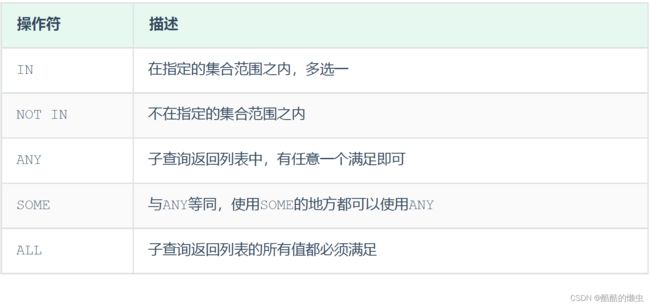
案例:
A. 查询 “销售部” 和 “市场部” 的所有员工信息
- 分解为以下两步:
-
- ①. 查询 “销售部” 和 “市场部” 的部门ID
select id from dept where name = '销售部' or name = '市场部';
-
- ②. 根据部门ID, 查询员工信息
select * from emp where dept_id in (select id from dept where name = '销售部' or name = '市场部');
B. 查询比 财务部 所有人工资都高的员工信息
- 分解为以下两步:
-
- ①. 查询所有 财务部 人员工资
select id from dept where name = '财务部';
select salary from emp where dept_id = (select id from dept where name = '财务部');
-
- ②. 比 财务部 所有人工资都高的员工信息
select * from emp where salary > all ( select salary from emp where dept_id = (select id from dept where name = '财务部') );
C. 查询比研发部其中任意一人工资高的员工信息
- 分解为以下两步:
-
- ①. 查询研发部所有人工资
select salary from emp where dept_id = (select id from dept where name = '研发部');
-
- ②. 比研发部其中任意一人工资高的员工信息
select * from emp where salary > any ( select salary from emp where dept_id = (select id from dept where name = '研发部') );
5.6.4 行子查询
子查询返回的结果是一行(可以是多列),这种子查询称为行子查询。
- 常用的操作符:
=、<>、in、not in
案例:
A. 查询与 “张无忌” 的薪资及直属领导相同的员工信息 ;
- 这个需求同样可以拆解为两步进行:
-
- ①. 查询 “张无忌” 的薪资及直属领导
select salary, managerid from emp where name = '张无忌';
-
- ②. 查询与 “张无忌” 的薪资及直属领导相同的员工信息 ;
select * from emp where (salary,managerid) = (select salary, managerid from emp where name = '张无忌');
5.6.5 表子查询
子查询返回的结果是 多行多列,这种子查询称为 表子查询。
- 常用的操作符:
in - 经常出现在
from之后,把表子查询返回的结果作为临时表,再和其他表进行联查操作。
案例:
A. 查询与 “鹿杖客” , “宋远桥” 的职位和薪资相同的员工信息
- 分解为两步执行:
-
- ①. 查询 “鹿杖客” , “宋远桥” 的职位和薪资
select job, salary from emp where name = '鹿杖客' or name = '宋远桥';
-
- ②. 查询与 “鹿杖客” , “宋远桥” 的职位和薪资相同的员工信息
select * from emp where (job,salary) in ( select job, salary from emp where name = '鹿杖客' or name = '宋远桥' );
B. 查询入职日期是 “2016-01-01” 之后的员工信息 , 及其部门信息
- 分解为两步执行:
-
- ①. 入职日期是 “2016-01-01” 之后的员工信息
select * from emp where entrydate > '2016-01-01';
-
- ②. 查询这部分员工, 对应的部门信息;
select e.*, d.* from (select * from emp where entrydate > '2016-01-01') e left join dept d on e.dept_id = d.id ;

多表查询 快速食用:---------------------------------------------------------------------------------------------------------------------------------------------------------------------------->
# 1、内连接
## 1.1). 隐式内连接
select 字段列表 from 表1 , 表2 where 条件 ... ;
## 1.2). 显式内连接
select 字段列表 from 表1 [ inner ] join 表2 on 连接条件 ... ;
# 2、外连接
## 2.1). 左外连接
select 字段列表 from 表1 left [ outer ] join 表2 on 条件 ... ;
## 2.2). 右外连接
select 字段列表 from 表1 right [ outer ] join 表2 on 条件 ... ;
# 3、自连接
select 字段列表 from 表A 别名A join 表A 别名B on 条件 ... ;
# 4、联合查询
select 字段列表 from 表A ...
union [ all ] # 注意是否需要去重
select 字段列表 from 表B ....;
# 5、子查询/嵌套查询
select * from t1 where column1 = ( select column1 from t2 );
## 5.1). 标量子查询
常用的操作符:= <> > >= < <=
## 5.2). 列子查询
常用的操作符:in 、not in 、 any 、some 、 all
## 5.3). 行子查询
常用的操作符:= 、<> 、in 、not in
## 5.4). 表子查询
常用的操作符:in
六、事务
6.1 事务简介
事务 是一组操作的集合,它是一个不可分割的工作单位,事务会把所有的操作作为一个整体一起向系统提交或撤销操作请求,即这些操作要么同时成功,要么同时失败。
就比如: 张三给李四转账1000块钱,张三银行账户的钱减少1000,而李四银行账户的钱要增加1000。 这一组操作就必须在一个事务的范围内,要么都成功,要么都失败。
- 正常情况: 转账这个操作, 需要分为以下这么三步来完成 , 三步完成之后, 张三减少1000, 而李四增加1000, 转账成功。
- 异常情况: 转账这个操作, 也是分为以下这么三步来完成 , 在执行第三步是报错了, 这样就导致张三减少1000块钱, 而李四的金额没变, 这样就造成了数据的不一致, 就出现问题了。
- 为了解决上述的问题,就需要通过数据的事务来完成,我们只需要在业务逻辑执行之前开启事务,执行完毕后提交事务。如果执行过程中报错,则回滚事务,把数据恢复到事务开始之前的状态。
注意: 默认MySQL的事务是自动提交的,也就是说,当执行完一条DML语句时,MySQL会立即隐式的提交事务。
6.2 事务操作
数据准备:
drop table if exists account;
create table account(
id int primary key AUTO_INCREMENT comment 'ID',
name varchar(10) comment '姓名',
money double(10,2) comment '余额'
) comment '账户表';
insert into account(name, money) VALUES ('张三',2000), ('李四',2000);
6.2.1 未控制事务
1). 测试正常情况
-- 1. 查询张三余额
select * from account where name = '张三';
-- 2. 张三的余额减少1000
update account set money = money - 1000 where name = '张三';
-- 3. 李四的余额增加1000
update account set money = money + 1000 where name = '李四';
测试完毕之后检查数据的状态, 可以看到数据操作前后是一致的。
-- 1. 查询张三余额
select * from account where name = '张三';
-- 2. 张三的余额减少1000
update account set money = money - 1000 where name = '张三';
程序抛出异常....
-- 3. 李四的余额增加1000
update account set money = money + 1000 where name = '李四';
- 我们把数据都恢复到2000, 然后再次一次性执行上述的SQL语句(出错了… 这句话不符合SQL语法,执行就会报错),检查最终的数据情况, 发现数据在操作前后不一致了。
6.2.2 控制事务一
⭐️ 1). 查看/设置事务提交方式
select @@autocommit ;
set @@autocommit = 0 ; -- 设置为手动提交,业务完成后也执行 commit 指令.
⭐️ 2). 提交事务
commit;
⭐️ 3). 回滚事务
rollback;
注意:上述的这种方式,我们是修改了事务的自动提交行为, 把默认的自动提交修改为了手动提交, 此时我们执行的DML语句都不会提交, 需要手动的执行
commit进行提交。
6.2.3 控制事务二
⭐️ 1). 开启事务
start transaction 或 begin ;
⭐️ 2). 提交事务
commit;
⭐️ 3). 回滚事务
rollback;
6.3 事务四大特性
- 原子性(Atomicity):事务是不可分割的最小操作单元,要么全部成功,要么全部失败。
- 一致性(Consistency):事务完成时,必须使所有的数据都保持一致状态。
- 隔离性(Isolation):数据库系统提供的隔离机制,保证事务在不受外部并发操作影响的独立环境下运行。
- 持久性(Durability):事务一旦提交或回滚,它对数据库中的数据的改变就是永久的。
6.4 并发事务问题
⭐️ 1). 赃读:一个事务读到另外一个事务还没有提交的数据。
- 比如A读取到了B未提交的数据。
⭐️ 2). 不可重复读:一个事务先后读取同一条记录,但两次读取的数据不同,称之为不可重复读。
- 事务A两次读取同一条记录,但是读取到的数据却是不一样的。
⭐️ 3). 幻读:一个事务按照条件查询数据时,没有对应的数据行,但是在插入数据时,又发现这行数据已经存在,好像出现了 “幻影”。

6.5 事务隔离级别
为了解决并发事务所引发的问题,在数据库中引入了事务隔离级别。主要有以下几种:
- 从上到下隔离级别越来越高,但性能越来越差。
⭐️ 1). 查看事务隔离级别
select @@transaction_isolation;
⭐️ 2). 设置事务隔离级别
set [ session | global ] transaction isolation level { read uncommitted | read committed | repeatable read | serializable }
注意:事务隔离级别越高,数据越安全,但是性能越低。






